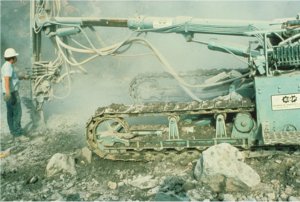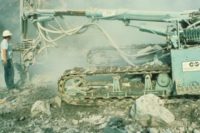
|
|
Silica exposure due to an unsafe work practice. Photo by NIOSH/John Rekus. |
The proposed rule to lower the permissible exposure limit (PEL) for crystalline silica got dusted off earlier this month after a long period of inactivity at the White House Office of Management and Budget (OMB).
Representatives from the American Foundry Society (AFS) meet with officials from the OMB, OSHA and the Department of Labor (DOL) on March 13 – the first such hearing about the rule since February of last year.
In the meeting, the AFS disputed an OSHA estimate that the cost of complying with the new silica standard of 0.05 mg/m would be approximately $150 million a year. The AFS cited a study estimating costs at ten times that amount, including $1.5 billion a year for engineering controls alone.
“Massive additional control efforts would be needed to attempt to comply with a reduced PEL of 0.05 mg/m,” according to the AFS presentation, which noted that a survey in 2011 found that more than 80% of foundries now have employees in areas that at least occasionally exceed 0.05 mg/m3.
The group said that compliance with the current PEL is difficult in foundry industry; about 60% of foundries have operations that exceed current PEL and sorting, knockoff and grinding operations are especially difficult.
“Respirators are now used to protect 8% of foundry employees who would otherwise be exposed above current PEL,” said the AFS, pointing out that respirator use “has been allowed by many OSHA settlement agreements, as a means of reducing exposures over PEL, usually after multiple attempts with a variety of engineering controls.”
The OMB held nine stakeholder meetings on the proposal between March and August 2011 with industry representatives, organized labor, and public health groups like by the American Thoracic Society.
Crystalline silica is an important industrial material found in construction, mining, manufacturing, maritime, and agriculture. Occupational exposure to crystalline silica often occurs as part of common workplace operations involving cutting, sawing, drilling, and crushing of concrete, brick, block, rock, and stone products (such as in construction work). Operations using sand products (such as glass manufacturing, foundries, and sand blasting) can result in worker inhalation of small (respirable) crystalline silica particles from the air. These types of exposures can lead to the development of disabling and sometimes fatal lung diseases, including silicosis and lung cancer. Processes historically associated with high rates of silicosis include sandblasting, sand-casting foundry operations, mining, tunneling, cement cutting and demolition, masonry work, and granite cutting.
Occupational health advocates have been sharply critical of the OMB’s delay in completing its review of the rule, which is long past the 45-day deadline specified in an Executive Order. The American Industrial Hygiene Association (AIHA) is among those calling for the OMB to finish the review. The National Advisory Committee on Occupational Safety and Health (NACOSH) is has called the delay “extraordinary and without explanation.”
"NACOSH is deeply distressed that the proposed silica standard has now been held by OMB for review for more than 10 months, far longer than the 4.5 month review period provided for in Executive Order 12866," said the group back in January, 2012.




